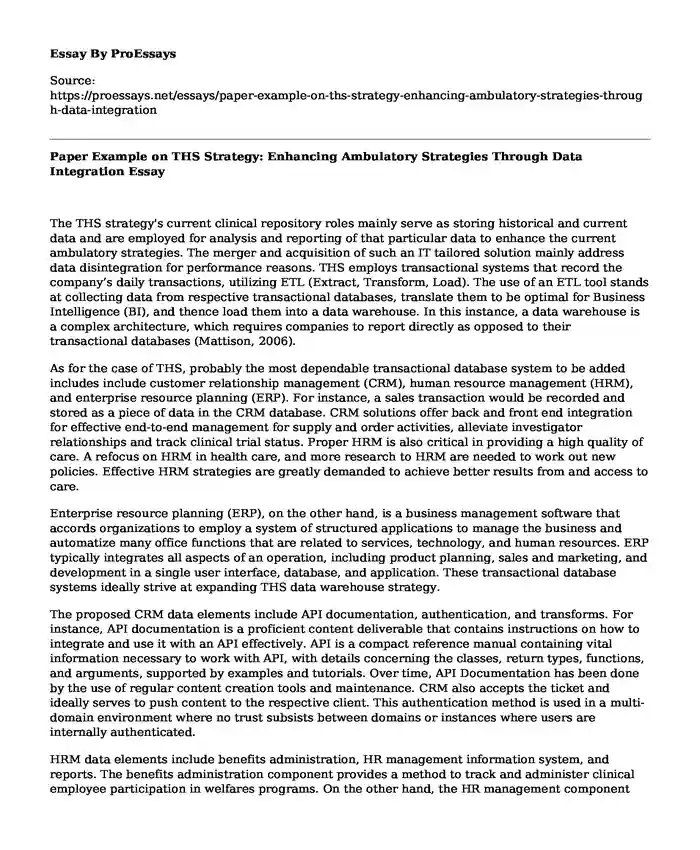The THS strategy's current clinical repository roles mainly serve as storing historical and current data and are employed for analysis and reporting of that particular data to enhance the current ambulatory strategies. The merger and acquisition of such an IT tailored solution mainly address data disintegration for performance reasons. THS employs transactional systems that record the company’s daily transactions, utilizing ETL (Extract, Transform, Load). The use of an ETL tool stands at collecting data from respective transactional databases, translate them to be optimal for Business Intelligence (BI), and thence load them into a data warehouse. In this instance, a data warehouse is a complex architecture, which requires companies to report directly as opposed to their transactional databases (Mattison, 2006).
As for the case of THS, probably the most dependable transactional database system to be added includes include customer relationship management (CRM), human resource management (HRM), and enterprise resource planning (ERP). For instance, a sales transaction would be recorded and stored as a piece of data in the CRM database. CRM solutions offer back and front end integration for effective end-to-end management for supply and order activities, alleviate investigator relationships and track clinical trial status. Proper HRM is also critical in providing a high quality of care. A refocus on HRM in health care, and more research to HRM are needed to work out new policies. Effective HRM strategies are greatly demanded to achieve better results from and access to care.
Enterprise resource planning (ERP), on the other hand, is a business management software that accords organizations to employ a system of structured applications to manage the business and automatize many office functions that are related to services, technology, and human resources. ERP typically integrates all aspects of an operation, including product planning, sales and marketing, and development in a single user interface, database, and application. These transactional database systems ideally strive at expanding THS data warehouse strategy.
The proposed CRM data elements include API documentation, authentication, and transforms. For instance, API documentation is a proficient content deliverable that contains instructions on how to integrate and use it with an API effectively. API is a compact reference manual containing vital information necessary to work with API, with details concerning the classes, return types, functions, and arguments, supported by examples and tutorials. Over time, API Documentation has been done by the use of regular content creation tools and maintenance. CRM also accepts the ticket and ideally serves to push content to the respective client. This authentication method is used in a multi-domain environment where no trust subsists between domains or instances where users are internally authenticated.
HRM data elements include benefits administration, HR management information system, and reports. The benefits administration component provides a method to track and administer clinical employee participation in welfares programs. On the other hand, the HR management component covers many different aspects, from diligence to retirement. The module addresses data and records basic demographic, training and development, selection, skills management and capabilities, compensation planning records, among other related activities. The Reports component provides customized coverage according to the individual needs of employees. Lastly, among the ERP data elements include CRM, HR, and inventory management systems, respectively. Probably the best inventory management module comes with tracking prominence that eliminates manual inventory control. These include a multi-level number tracking and multiple units of ”measure per product ID.”
Comments
The genuine respect of business intelligence falls out when business data and information is blended with business analysis in-depth in a manner that makes it capable of making well-informed decisions. To ensure this, THS, alongside its technical departments, needs to devise and deliver input stimulation to the BI tools. A business intelligence tool is applied differently by different companies to create strategic business advantage but requires expressed knowledge for the processes. The efficiency of employing BI tools alongside data warehousing stands at determining how THS stores and handles its information towards its provision of ambulatory EMR.
Basing on the strategic organization of THS, I would recommend ERP source system. The basic goal to employing an enterprise resource planning (ERP) system is to furnish one central repository serving as an essential component for all shared information by all the ERP facets in improving the data flow across the organization. This is a feature I’d ideally push for mainly due to its cutting edge emerging trends including Mobile ERP, Social ERP, cloud ERP and two-tier ERP respectively (Parthasarathy, 2007). Presently, as more data is electronically stored, the basis on which business intelligence tools rely becomes wider in scope and importance.
References
Mattison, R. (2006). The data warehousing handbook. Oakwood Hills, Ill: XiT Press. http://www.diva-portal.org/smash/get/diva2:578277/FULLTEXT01.pdf
Rainardi, V. (2008). Building a data warehouse with examples in SQL Server. Berkeley, CA: Apress.
Elliott, G. (2004). Global business information technology: An integrated systems approach. Harlow: Financial Times Prentice Hall.
Parthasarathy, S. (2007). Enterprise resource planning (ERP): A managerial and technical perspective. New Delhi: New Age International.
Cite this page
Paper Example on THS Strategy: Enhancing Ambulatory Strategies Through Data Integration. (2023, Sep 24). Retrieved from https://proessays.net/essays/paper-example-on-ths-strategy-enhancing-ambulatory-strategies-through-data-integration
If you are the original author of this essay and no longer wish to have it published on the ProEssays website, please click below to request its removal:
- Economic Policies for Developing Countries Paper Example
- Paper Example on Move to Higher Price: Lower Sales & Lower Royalties?
- Non-Profits: Challenges, Deaths, Rebrands, and More - Research Paper
- Unlock the Benefits of SAFe: Reasons & Steps to Implement - Essay Sample
- Pikes Peak Steel: Improving Employee Safety with CSU OSHA Partnership - Essay Sample
- Essay on Popularity of Instagram Among 126 Study Participants: High Purchase of Goods Observed
- Market Research on Hulu - Report Example







